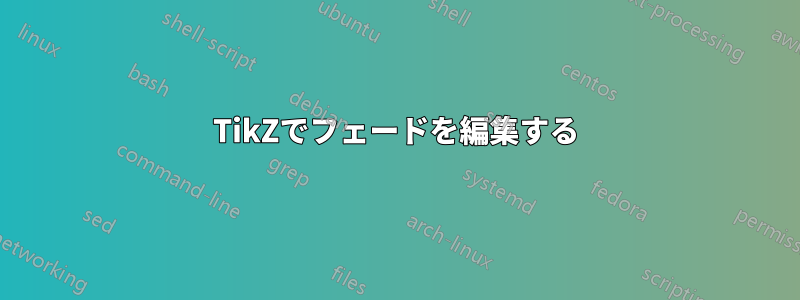
filldrawカスタムフェード(つまり、上部の塗りつぶし = color1、下部の塗りつぶし = color2 など)を持つ四角形があり、これは\shade次のオプションを使用して定義されます。役職トビアス・ブリンク著。
実現したい編集は 2 つあります。
- 境界線を描くない塗りつぶしとともにフェードアウトしますが、透明度が 100 に設定されている場所 (つまり白い部分) では消えます。
- 北東と南東の角だけを回る?これは、
nodes次のような場合に答えられます役職ですが、ここでは動作させることができません。 - テキストは透明化されずに表示されます。
ムウェ
\documentclass[tikz]{standalone} \usetikzlibrary{fadings}
\begin{tikz fadinfrompicture}[name=myfading]
\clip (0,0) rectangle (2,2);
\shade [top color=transparent!100, bottom color=transparent!0] (0,0) rectangle (2,0.38);
\shade [top color=transparent!10, bottom color=transparent!100] (0,0.68) rectangle (2,0.92);
\shade [top color=transparent!100, bottom color=transparent!10] (0,0.92) rectangle (2,1.16);
\shade [top color=transparent!0, bottom color=transparent!100] (0,1.59) rectangle (2,2);
\end{tikzfadingfrompicture}
\begin{document}
\begin{tikzpicture}
\filldraw [blue, path fading=myfading, draw=black, line width=1mm, text opacity = 1] (10,0) rectangle (19,-11.5) node[pos=.5,text width=8 cm] {Some text without transparency};
\end{tikzpicture}
\end{document}
これにより、次の出力が生成されます。
答え1
最初の点については、もう少しレベルを下げる必要があると思います。境界線を通常のままにしておくのは簡単です。境界線をフェードさせるのはもっと簡単です。しかし、あなたが求めているのは描かない国境のみフェードが完全に透明の場合、カスタム コードなしでこれを実行する方法はないと思います。
他の2つについては:
- 丸い角:を使用せずに単一の線でパスを構築すると
rectangle、色合いは変化しません。例:
\draw (0,0) to[rounded corners] (0,2) to[rounded corners] (2,2) -- (2,0) -- cycle; - テキストの透明度:
text opacity確かにここでは機能しませんが、すべてをノードに置き換え、その境界スタイルにいくつかのカスタム オプションを追加するだけで済みます。
コードは次のとおりです:
\documentclass[tikz,margin=10pt]{standalone}
\usetikzlibrary{fadings}
\definecolor{myblue}{RGB}{80,103,173}% my blue is different than yours
\begin{tikzfadingfrompicture}[name=myfading]
\clip (0,0) rectangle (2,2);
\shade [top color=transparent!100, bottom color=transparent!0] (0,0) rectangle (2,0.38);
\shade [top color=transparent!10, bottom color=transparent!100] (0,0.68) rectangle (2,0.92);
\shade [top color=transparent!100, bottom color=transparent!10] (0,0.92) rectangle (2,1.16);
\shade [top color=transparent!0, bottom color=transparent!100] (0,1.59) rectangle (2,2);
\end{tikzfadingfrompicture}
\tikzset{
special/.style={%
text=myblue,
minimum height=10cm,
minimum width=10cm,
inner sep=0,
text width=8cm,
append after command={% custom border and fill!
\pgfextra
\fill[preaction={draw=black,line width=1mm}, myblue, path fading=myfading]
(\tikzlastnode.south west) to[rounded corners=1cm]
(\tikzlastnode.north west) to[rounded corners=1cm]
(\tikzlastnode.north east) --
(\tikzlastnode.south east) -- cycle;
\endpgfextra
}
}
}
\begin{document}
\begin{tikzpicture}
\node[special] at (5,5) {Some text without transparency\\Some text without transparency\\Some text without transparency\\Some text without transparency\\Some text without transparency\\Some text without transparency\\Some text without transparency\\};
\end{tikzpicture}
\end{document}
そして結果:
答え2
abcdefgからのフィードバックを受けて\pgfextra、私は別の解決策に取り組むことにしました。これはあなた自身で評価することができます。私は次のコマンドを作成しました。
\specrect[ <options> ]{ <position> }{ <text> }
text widthオプションには、、、など、ノードに適用できるすべてのオプションが含まれますtext。minimum width / height / sizeここで使用できる唯一のカスタム オプションは、角を鋭くするか丸くするか (丸くする場合はどの程度丸くするか) を決定することであり、次の順序で決定します (区切り文字はカンマです)。
set corners={ north west, north east, south west, south east }
オプションが指定されていない場合、すべてのコーナーはrounded corners=0、つまり鋭角になります。以下の例では、どのように機能するかを示すために上部のコーナーを変更しました。
出力
コード
\documentclass[tikz, margin=10pt]{standalone}
\usetikzlibrary{fadings}
\definecolor{myblue}{RGB}{80,103,173}
\begin{tikzfadingfrompicture}[name=myfading]
\clip (0,0) rectangle (2,2);
\shade [top color=transparent!100, bottom color=transparent!0] (0,0) rectangle (2,0.38);
\shade [top color=transparent!10, bottom color=transparent!100] (0,0.68) rectangle (2,0.92);
\shade [top color=transparent!100, bottom color=transparent!10] (0,0.92) rectangle (2,1.16);
\shade [top color=transparent!0, bottom color=transparent!100] (0,1.59) rectangle (2,2);
\end{tikzfadingfrompicture}
\pgfkeys{/tikz/.cd,% to set the path
nwcorner/.initial=0,
nwcorner/.get=\nwcorner,
nwcorner/.store in=\nwcorner,
necorner/.initial=0,
necorner/.get=\necorner,
necorner/.store in=\necorner,
swcorner/.initial=0,
swcorner/.get=\swcorner,
swcorner/.store in=\swcorner,
secorner/.initial=0,
secorner/.get=\secorner,
secorner/.store in=\secorner,
set corners/.style args={#1,#2,#3,#4}{nwcorner=#1,necorner=#2,swcorner=#3,secorner=#4},
}
\newcommand\specrect[3][]{%
\tikzset{nwcorner=0,necorner=0,swcorner=0,secorner=0,set corners={0,0,0,0},#1}
\node (specialr) at (#2) {};
\filldraw[preaction={draw=black, line width=1mm},myblue, path fading=myfading]
(specialr.south west) to[rounded corners=\nwcorner]
(specialr.north west) to[rounded corners=\necorner]
(specialr.north east) to[rounded corners=\swcorner]
(specialr.south east) to[rounded corners=\secorner] cycle;
\node at (#2) {#3};
}
\begin{document}
\begin{tikzpicture}
\specrect[
text=myblue,
minimum height=10cm,
minimum width=10cm,
inner sep=0,
text width=8cm,
set corners={1cm,3cm,0,0}% nw, ne, sw, se
]{0,0}{Some text without transparency}
\end{tikzpicture}
\end{document}
答え3
リクエストに応じて: のないバージョン\pgfextra、これはないパス操作には を使用します。path picture代わりに を使用することもできます。境界が必要な場合は、一般的に を追加するだけで済みますdraw。今回のケースでは、一部の角のみに丸みを帯びているため、 を使用できますappend after command。ただし、これによって境界がどこにあるかを「知っている」ノードが提供されないことに注意してください。つまり、丸みを帯びた角の近くで接続パスを正しく描画しません。このためには、新しいシェイプを定義する必要があります。
\documentclass[tikz]{standalone}
\usetikzlibrary{calc,fadings}
\begin{tikzfadingfrompicture}[name=myfading]
\clip (0,0) rectangle (2,2);
\shade [top color=transparent!100, bottom color=transparent!0] (0,0) rectangle (2,0.38);
\shade [top color=transparent!10, bottom color=transparent!100] (0,0.68) rectangle (2,0.92);
\shade [top color=transparent!100, bottom color=transparent!10] (0,0.92) rectangle (2,1.16);
\shade [top color=transparent!0, bottom color=transparent!100] (0,1.59) rectangle (2,2);
\end{tikzfadingfrompicture}
\begin{document}
\begin{tikzpicture}[faded/.style={path picture={
\fill[blue, path fading=myfading]
let \p1=($(path picture bounding box.north east)-(path picture bounding box.south west)$),
\n1={0.15*min(\x1,\y1)} in [rounded corners=\n1]
(path picture bounding box.south west) |-
(path picture bounding box.north east) [sharp corners] |- cycle;
},append after command={[ultra thick] let
\p1=($(\tikzlastnode.north east)-(\tikzlastnode.south west)$),
\n1={0.15*min(\x1,\y1)} in
(\tikzlastnode.south west) edge[ultra thick,line cap=rect,vh path,rounded corners=\n1] (\tikzlastnode.north)
(\tikzlastnode.south east) edge[ultra thick,line cap=rect,vh path,rounded corners=\n1] (\tikzlastnode.north)
(\tikzlastnode.south west) edge[ultra thick,line cap=rect] (\tikzlastnode.south east)
}},vh path/.style={to path={|- (\tikztotarget)}}]
\path node[minimum size=10cm,text width=8cm,faded]
{Some text without transparency};
\end{tikzpicture}
\end{document}
よりクリーンなバージョンは、角が丸い長方形。
\documentclass{article}
\usepackage{tikz}
\usetikzlibrary{intersections}
\usetikzlibrary{calc,fadings}
\begin{tikzfadingfrompicture}[name=myfading]
\clip (0,0) rectangle (2,2);
\shade [top color=transparent!100, bottom color=transparent!0] (0,0) rectangle (2,0.38);
\shade [top color=transparent!10, bottom color=transparent!100] (0,0.68) rectangle (2,0.92);
\shade [top color=transparent!100, bottom color=transparent!10] (0,0.92) rectangle (2,1.16);
\shade [top color=transparent!0, bottom color=transparent!100] (0,1.59) rectangle (2,2);
\end{tikzfadingfrompicture}
\begin{document}
\makeatletter
% from https://tex.stackexchange.com/a/118786/228539
\pgfkeys{/pgf/.cd,
rectangle corner radius north west/.initial=0pt,
rectangle corner radius north east/.initial=0pt,
rectangle corner radius south west/.initial=0pt,
rectangle corner radius south east/.initial=0pt
}
\newif\ifpgf@rectanglewrc@donecorner@
\def\pgf@rectanglewithroundedcorners@docorner#1#2#3#4#5{%
\edef\pgf@marshal{%
\noexpand\pgfintersectionofpaths
{%
\noexpand\pgfpathmoveto{\noexpand\pgfpoint{\the\pgf@xa}{\the\pgf@ya}}%
\noexpand\pgfpathlineto{\noexpand\pgfpoint{\the\pgf@x}{\the\pgf@y}}%
}%
{%
\noexpand\pgfpathmoveto{\noexpand\pgfpointadd
{\noexpand\pgfpoint{\the\pgf@xc}{\the\pgf@yc}}%
{\noexpand\pgfpoint{#1}{#2}}}%
\noexpand\pgfpatharc{#3}{#4}{#5}%
}%
}%
\pgf@process{\pgf@marshal\pgfpointintersectionsolution{1}}%
\pgf@process{\pgftransforminvert\pgfpointtransformed{}}%
\pgf@rectanglewrc@donecorner@true
}
\pgfdeclareshape{rectangle with rounded corners}
{
\inheritsavedanchors[from=rectangle] % this is nearly a rectangle
\inheritanchor[from=rectangle]{north}
\inheritanchor[from=rectangle]{north west}
\inheritanchor[from=rectangle]{north east}
\inheritanchor[from=rectangle]{center}
\inheritanchor[from=rectangle]{west}
\inheritanchor[from=rectangle]{east}
\inheritanchor[from=rectangle]{mid}
\inheritanchor[from=rectangle]{mid west}
\inheritanchor[from=rectangle]{mid east}
\inheritanchor[from=rectangle]{base}
\inheritanchor[from=rectangle]{base west}
\inheritanchor[from=rectangle]{base east}
\inheritanchor[from=rectangle]{south}
\inheritanchor[from=rectangle]{south west}
\inheritanchor[from=rectangle]{south east}
\savedmacro\cornerradiusnw{%
\edef\cornerradiusnw{\pgfkeysvalueof{/pgf/rectangle corner radius north west}}%
}
\savedmacro\cornerradiusne{%
\edef\cornerradiusne{\pgfkeysvalueof{/pgf/rectangle corner radius north east}}%
}
\savedmacro\cornerradiussw{%
\edef\cornerradiussw{\pgfkeysvalueof{/pgf/rectangle corner radius south west}}%
}
\savedmacro\cornerradiusse{%
\edef\cornerradiusse{\pgfkeysvalueof{/pgf/rectangle corner radius south east}}%
}
\backgroundpath{%
\northeast\advance\pgf@y-\cornerradiusne\relax
\pgfpathmoveto{}%
\pgfpatharc{0}{90}{\cornerradiusne}%
\northeast\pgf@ya=\pgf@y\southwest\advance\pgf@x\cornerradiusnw\relax\pgf@y=\pgf@ya
\pgfpathlineto{}%
\pgfpatharc{90}{180}{\cornerradiusnw}%
\southwest\advance\pgf@y\cornerradiussw\relax
\pgfpathlineto{}%
\pgfpatharc{180}{270}{\cornerradiussw}%
\northeast\pgf@xa=\pgf@x\advance\pgf@xa-\cornerradiusse\southwest\pgf@x=\pgf@xa
\pgfpathlineto{}%
\pgfpatharc{270}{360}{\cornerradiusse}%
\northeast\advance\pgf@y-\cornerradiusne\relax
\pgfpathlineto{}%
\pgfpathclose
}
\anchor{before north east}{\northeast\advance\pgf@y-\cornerradiusne}
\anchor{after north east}{\northeast\advance\pgf@x-\cornerradiusne}
\anchor{before north west}{\southwest\pgf@xa=\pgf@x\advance\pgf@xa\cornerradiusnw
\northeast\pgf@x=\pgf@xa}
\anchor{after north west}{\northeast\pgf@ya=\pgf@y\advance\pgf@ya-\cornerradiusnw
\southwest\pgf@y=\pgf@ya}
\anchor{before south west}{\southwest\advance\pgf@y\cornerradiussw}
\anchor{after south west}{\southwest\advance\pgf@x\cornerradiussw}
\anchor{before south east}{\northeast\pgf@xa=\pgf@x\advance\pgf@xa-\cornerradiusse
\southwest\pgf@x=\pgf@xa}
\anchor{after south east}{\southwest\pgf@ya=\pgf@y\advance\pgf@ya\cornerradiusse
\northeast\pgf@y=\pgf@ya}
\anchorborder{%
\pgf@xb=\pgf@x% xb/yb is target
\pgf@yb=\pgf@y%
\southwest%
\pgf@xa=\pgf@x% xa/ya is se
\pgf@ya=\pgf@y%
\northeast%
\advance\pgf@x by-\pgf@xa%
\advance\pgf@y by-\pgf@ya%
\pgf@xc=.5\pgf@x% x/y is half width/height
\pgf@yc=.5\pgf@y%
\advance\pgf@xa by\pgf@xc% xa/ya becomes center
\advance\pgf@ya by\pgf@yc%
\edef\pgf@marshal{%
\noexpand\pgfpointborderrectangle
{\noexpand\pgfqpoint{\the\pgf@xb}{\the\pgf@yb}}
{\noexpand\pgfqpoint{\the\pgf@xc}{\the\pgf@yc}}%
}%
\pgf@process{\pgf@marshal}%
\advance\pgf@x by\pgf@xa%
\advance\pgf@y by\pgf@ya%
\pgfextract@process\borderpoint{}%
%
\pgf@rectanglewrc@donecorner@false
%
% do southwest corner
\southwest\pgf@xc=\pgf@x\pgf@yc=\pgf@y
\advance\pgf@xc\cornerradiussw\relax\advance\pgf@yc\cornerradiussw\relax
\borderpoint
\ifdim\pgf@x<\pgf@xc\relax\ifdim\pgf@y<\pgf@yc\relax
\pgf@rectanglewithroundedcorners@docorner{-\cornerradiussw}{0pt}{180}{270}{\cornerradiussw}%
\fi\fi
%
% do southeast corner
\ifpgf@rectanglewrc@donecorner@\else
\southwest\pgf@yc=\pgf@y\relax\northeast\pgf@xc=\pgf@x\relax
\advance\pgf@xc-\cornerradiusse\relax\advance\pgf@yc\cornerradiusse\relax
\borderpoint
\ifdim\pgf@x>\pgf@xc\relax\ifdim\pgf@y<\pgf@yc\relax
\pgf@rectanglewithroundedcorners@docorner{0pt}{-\cornerradiusse}{270}{360}{\cornerradiusse}%
\fi\fi
\fi
%
% do northeast corner
\ifpgf@rectanglewrc@donecorner@\else
\northeast\pgf@xc=\pgf@x\relax\pgf@yc=\pgf@y\relax
\advance\pgf@xc-\cornerradiusne\relax\advance\pgf@yc-\cornerradiusne\relax
\borderpoint
\ifdim\pgf@x>\pgf@xc\relax\ifdim\pgf@y>\pgf@yc\relax
\pgf@rectanglewithroundedcorners@docorner{\cornerradiusne}{0pt}{0}{90}{\cornerradiusne}%
\fi\fi
\fi
%
% do northwest corner
\ifpgf@rectanglewrc@donecorner@\else
\northeast\pgf@yc=\pgf@y\relax\southwest\pgf@xc=\pgf@x\relax
\advance\pgf@xc\cornerradiusnw\relax\advance\pgf@yc-\cornerradiusnw\relax
\borderpoint
\ifdim\pgf@x<\pgf@xc\relax\ifdim\pgf@y>\pgf@yc\relax
\pgf@rectanglewithroundedcorners@docorner{0pt}{\cornerradiusnw}{90}{180}{\cornerradiusnw}%
\fi\fi
\fi
}
}
\makeatother
\begin{tikzpicture}[faded/.style={path picture={
\fill[blue, path fading=myfading]
(path picture bounding box.south west) rectangle
(path picture bounding box.north east);}}]
\path node[rectangle with rounded corners,minimum size=10cm,
text width=8cm,faded,draw,ultra thick,font=\sffamily,
rectangle corner radius north west=20pt]
{Some text without transparency};
\end{tikzpicture}
\end{document}







